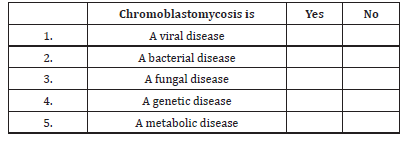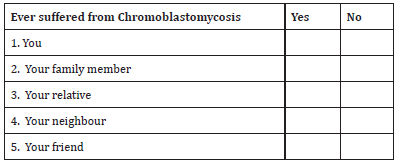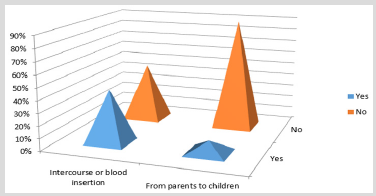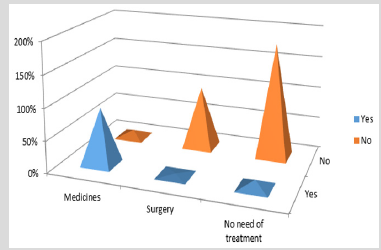Lupine Publishers Journal of Surgery and Journal of Case Studies: Currently case studies drag the concentration of the investigators since each case present provides deep understanding in diagnosis and treatment methods. It is devoted to publishing case series and case reports. Articles must be genuine
Friday, July 30, 2021
Lupine Publishers: Lupine Publishers| The Relationship of the Trigemi...
Lupine Publishers| Perspective of Youth about Chromoblastomycosis
Lupine Publishers | Journal of Health Research and Reviews
Abstract
Objectives of the present study were to evaluate the perspective of youth about chromoblastomycosis. A total of 100 subjects were asked to answer the questionnaire. The subjects were students in Bahauddin Zakariya University Multan, Pakistan. Alexander pedroso in Saopolo, Brazil studied the cases of Chromoblastomycosis in 1911. The name of disease was blastomycosa negra. The name of a disease figueria described by German Physician. It was done from the current study that most of the females said that chromoblastomycosis was not a viral, fungal, bacterial disease. There is a 50% chance whether it may or may not be a viral, fungal or bacterial.
Keywords:Chromoblastomycosis; Fungal Disease; Cauliflower
Introduction
Fungal infection of the skin is the Chromoblastomycosis, which is a long-term. Often in rural areas, in tropical or subtropical climates this infection occurs such as Madagascar in Africa and Brazil in South America . By many different types of fungi, this infection can be caused. Very slowly, chromoblastomycosis spreads. It is not often lethal and usually has a good projection, but it’s cure is very difficult. Medication and surgery, the several treatments include. Among the subcutaneous mycoses and is ubiquitous, Chromoblastomycosis is classified. Chromoblastomycosis disease was recommended by the International Society for Human and Animal Mycology in 1992.On the foot or leg chromoblastomycosis begins [1]. Where the skin is wrecked, other exposed body parts may be infected. Papules are formed in this disease. Dull red patches are formed when these papules extend. Objectives of the present study were to evaluate the perspective of youth about chromoblastomycosis (Tables 1-4).
Materials and Method
Results
Presence and absence of chromoblastomycosis in male and female is shown in the (Figures 1-4). In the first column graph it was showed that most of the females said that Chromoblastomycosis was not a viral disease and most males also said that it is not a viral. Most of the females took this disease not as a bacterial and most males said that it was not a bacterial disease [2-5]. Most of the females said that it was not a fungal disease and males also had a same opinion. Both males and females said that chromoblastomycosis was not a genetic disease. Most females said that chromoblastomycosis was a metabolic disease. But when we observed the disease then we concluded that chromoblastomycosis was a fungal disease. Then, next question asked from them that whether you, your family member, relative, neighbor and friend suffered from this disease or not then most of the females and males said no. The other question asked to them whether the disease by contacts or blood transfer or from parents to offspring was transmitted or not then the most females said that disease was not transmitted by contacts or blood transfer or from parents to offspring. The other question were that either the disease was treated by medicines, surgery or no treatment was available for that then most females and males said that it could be treated by medicines [5-8].
Discussion
In recent studies, questionnairebased studies had given an important development. Alexandre pedroso in Saopolo, Brazil studied the cases of Chromoblastomycosis in 1911. The name of disease was blastomycosa negra. The name of a disease figueria described by German Physician [9,10].
Conclusion
From present study, it was concluded that most of the females said that chromoblastomycosis was not a viral, fungal, bacterial disease. There is a 50% chance whether it may or may not be a viral, fungal or bacterial.
For more Lupine Publishers Open Access Journals Please visit our website:
https://lupinepublishers.blogspot.com/
For more Research and Reviews on Healthcare articles Please Click Here:https://lupinepublishers.com/research-and-reviews-journal/
Tuesday, July 27, 2021
Lupine Publishers: Lupine Publishers | Liquid Chromatography-Mass Spe...
Friday, July 23, 2021
Lupine Publishers: Lupine Publishers| Nanoparticles and the Building ...
Thursday, July 22, 2021
Lupine Publishers: Lupine Publishers| It Is Disturbing, In Spite of T...
Tuesday, July 20, 2021
Lupine Publishers: Lupine Publishers| Utilization of Traditional Anti...
Friday, July 16, 2021
Lupine Publishers: Lupine Publishers | The Rate of Cerebral Blood Flo...
Thursday, July 15, 2021
Lupine Publishers: Lupine Publishers| Utilization of Traditional Anti...
Wednesday, July 14, 2021
Lupine Publishers: Lupine Publishers| Utilization of Traditional Anti...
Tuesday, July 13, 2021
Lupine Publishers: Lupine Publishers| Forces Acting on A Bearing of a...
Monday, July 12, 2021
Lupine Publishers| Bitter Gourd Relish and Blood Group Relationship
Lupine Publishers | Journal of Health Research and Reviews
Abstract
The topic of our project was to explore the “Bitter gourd relish and blood group relationship.” The number of subjects to examine were 176. The process we adopted before examining the subjects was acquiring their consent before the collection of related information. We checked blood group of the subjects by using lancing device along with anti-sera A, B and D solutions and then noted the precipitate formation. In the meanwhile we asked whether they liked bitter gourd as a dish or not. We gathered the basic information about bitter gourd composition and its merits for the subjects that used it as a dish or juice. Then we organized the random data presented in a table and observed the relationship of bitter gourd liking to blood type and made a comparative analysis of blood groups. At the end, we defined the results.
Keywords:Bitter Gourd; Blood Grouping; Bitter Melon; Karela; Fondness; Relish; Liking
Introduction
Human beings has a fluid inside their bodies known as blood. Blood comprises leukocytes, erythrocytes, and platelets. ABO Blood Group system was first discovered in 1901 by Karl Landsteiner. The classification of human blood group is based on antigens and antibodies present in blood. Antibodies are the natural immune system proteins that act as a defense mechanism. ABO system is encoded by gene I located on chromosome 9. This gene is polymorphic having three alleles represented as Iᵃ, Iᵇ and i. If a subject has blood group A, then it means it has antigen A present on its red blood cells and antibody B is present. So, genotype IᵃIᵃ or Iᵃi, will produce phenotype A. Subject having genotype IᵇIᵇ or Iᵇi will produce phenotype B. Subject having AB blood, no antibody is present, and genotype is IᵃIᵇ. If blood group is O, this subject has no antigens and both antibodies are present in the blood plasma. So, the homozygous recessive genotype ii produces the phenotype O. The universal donor is O blood group and can donate blood to group A and group B types. The universal recipient is AB group, means it can take blood from any donor like from group A, B and O [1]. There is another protein known as Rh protein or Rh factor present on erythrocytes. A subject is Rh positive when the Rh protein is present and Rh negative if Rh protein is absent. So, blood group of a subject may be A⁻, A⁺, B⁻, B⁺, AB⁻, AB⁺, O⁺ and O⁻ [2].
Bitter gourd a vegetable, also known as bitter melon, bitter squash, balsam pear, and simply as karela (in Urdu). The scientific name of bitter gourd is Momordica chianti. Bitter gourd a vine of the family Cucurbitaceae, grown mostly in Asia and Africa [3]. Bitter gourd juice consists of nutrients like iron, magnesium, potassium and vitamin C. It is rich in dietary fiber. It contains two- fold of calcium of spinach, potassium of banana and beta-carotene. The compound momordicines and increased levels of calcium is the cause of characteristic bitterness of bitter gourd. Bitter gourd contains diabetic control compounds naturally. Also, bitter squash juice is anti-inflammatory and lowers bad cholesterol levels in human body and acid lessons the risk of heart of stroke and heart attack due to enrichment in iron and folic acid. It maintains the blood pressure of body. Anti-oxidants along with vitamins like C and A in bitter gourd retards premature skin ageing and minimizes wrinkles. Momordica charantia, a compound strengthens the anti-oxidant activity of liver enzyme and provides defense against liver failure and removes intoxication caused by frequent alcohol uptakes that settled down in liver. It also boosts functioning of bladder. Bitter melon contains less amount of carbohydrates, calories and fat, that play role in removal of already present fat cells and inhibits the generation of new fat cells. Anti-oxidants in bitter melon reduces the risk of cervical, prostate and breast cancer in humans. Bitter gourd decreases the sight-related problems such as cataract as being rich in vitamin A and beta-carotene and strengthens eyesight [4]. Objective of present study was correlating blood groupings with bitter gourd.
Materials and Method
Blood Grouping
The materials required to test blood group were the required quantity of blood from specific groups (three drops) was taken for testing with a prick of sterilized needle (blood lancet) on a fingertip (any), slides and solutions of anti-sera A (antigen A with B antibody), anti-sera B (contains antigens B with A antibodies) and anti-sera D (Rh +ve factor). Anti-sera means the solution contains opposite antibody with respect to antigen. First, label the slide with A, B, and D so that anti-sera drops can be identified. Then placed three drops of blood on the slide. Afterwards, add a or few drop of anti- sera A, anti-sera B, anti-sera D according to the labeling on the slide. In the end, leave the slide for two to three minutes or mix each drop with needle wire and observe the changes in drop solution. Precipitate formation of blood drop shows that blood group presence in subject. Precipitate formation in anti-sera D, meant positive. Precipitate formation in any anti-sera A, B and D, then A⁺, B⁺ blood group. If precipitates were formed in all three anti-sera A, B and D, then blood group was AB⁺. If precipitates were formed in only anti-sera D blood group was O⁺ and no precipitate in any anti-sera, meant that blood group was O⁻. If precipitates were formed in either anti-sera A or B, or both then blood group was A⁻, B⁻ and AB⁻ respectively.
Project Designing
The topic we selected was bitter gourd relish. We asked subjects whether they like bitter gourd as a dish or not because of its bitter taste. Subjects also gave their consent to check their blood group. Then we organized the random data and did the statistical analysis. The subjects which we chose for our project, were the 176 students of Bahauddin Zakariya University, Multan Pakistan.
Statistical analysis
We did Statistical analysis by using MS Excel
Results and Dicussion
Studies based on questionnaire have given an important advancement in science [5-12]. No linkage or research work was found that correlated my topic (Table 1).
Conclusion
The present study concluded in figure (A) that bitter gourd fondness was shown mostly by B⁺ subjects. B⁺ blood group subjects liked the bitter melon most. The frequent occurrence of similar blood group of my subjects were B⁺. All the subjects of our research having O⁻ blood group were females and they all liked the bitter melon. The likeliness percentage of subjects with blood group O⁺ and B⁺ were same, (11%). All blood group AB⁻ and B⁻ subjects liked bitter squash. Out of 46 male subjects, bitter melon was liked by 30 males. Total 92 female subjects liked the taste of bitter squash as a dish out of 130.
For more Lupine Publishers Open Access Journals Please visit our website:
https://lupinepublishers.blogspot.com/
For more Research and Reviews on Healthcare articles Please Click Here:https://lupinepublishers.com/research-and-reviews-journal/
Friday, July 9, 2021
Lupine Publishers: Lupine Publishers| Influence of Inoculation Method...
Thursday, July 8, 2021
Lupine Publishers: Lupine Publishers| Influence of Inoculation Method...
Wednesday, July 7, 2021
Lupine Publishers: Lupine Publishers| Evaluation of the Prevalence of...
Tuesday, July 6, 2021
Lupine Publishers: Lupine Publishers| Evaluation of the Prevalence of...
Thursday, July 1, 2021
Lupine Publishers: Lupine Publishers | Antifungal Properties of Some ...
Lupine Publishers: Lupine Publishers| A Standard Pediatric Dental Clinic
Lupine Publishers: Lupine Publishers| A Standard Pediatric Dental Clinic : Lupine Publishers| Journal of Dentistry and Oral Health Care Aft...
-
Lupine Publishers | Journal of Health Research and Reviews Abstract Metabolism is the process your body uses to make energy f...
-
Heat wave killings in Pakistan and possiblestrategies to prevent the future heat wave fatalities by Syed Zawar Shah in Research and ...
-
To Examine the Relationship and Strength of Alcohol-Related Intimate Partner Violence in sub-Saharan Africa by Ekpenyong MS in Rese...













